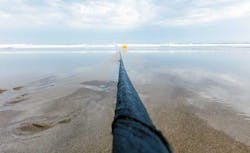Cloud data centers are continuing to reshape global Internet architecture, including the subsea cables that extend the networks across oceans. Capacity demand from hyperscale operators will be a key driver in $8 billion in new cable investments over the next three years, according to research firm TeleGeography.
The latest investment trends in subsea cables is outlined in the TeleGeography’s 2021 Submarine Cable Map, the latest edition of a key information resource on cable deployments, landing stations, and the growing role of content providers.
The 2021 map documents 464 global cables and 1,245 landing stations, as well as major future deployments. The map further analyzes the changing dynamics in the market and influence of new players on submarine cable investments.
That includes 36 cables in the planning stages, including 19 newly-announced projects that will add more than 103,000 kilometers (64,000 miles) to global subsea lengths.
“The 2021 map illustrates a market that’s experiencing more deployments, with new and diverse players,” said TeleGeography Research Director Alan Mauldin. “Over the last decade, we’ve seen content providers emerge as disruptors, ramping up investments to meet global demand for their services. The submarine cable market has never been so dynamic.”
This could mean a lot of business for leading players in subsea cable deployment. “Only a handful of suppliers are involved in cable construction,” TeleGeography notes. “Three suppliers — Subcom, ASN, and NEC — account for 90% of the new construction market since 2017 (measured by total cable length).”
Source: TeleGeography
Cloud and Content Drive Capacity Growth
Subsea cables connect the digital economy across the world, tying continents and data centers together. But the path of these cables is changing, along with how they are funded. Over the past decade, the major cloud and social media platforms have become the largest users of subsea cables as they send data to their users across the world. Content providers like Amazon, Google, Facebook, and Microsoft accounted for less than 10% of cable capacity prior to 2012, but their share of total capacity surged to 66% in 2020.
Unlike in previous cable construction booms, these hyperscale content providers are taking a more active role in the submarine cable market. “These companies alone have such incredible demand for data center traffic that they’re driving projects and route prioritization for submarine cable systems,” said TeleGeography.
The leading example of this trend is Google, which has invested in 16 subsea cables. The newest is Firmina, which was announced last week and will move traffic between the East Coast of the U.S. and South America. The cable will bring traffic to Las Toninas, Argentina, with additional landings in Praia Grande, Brazil, and Punta del Este, Uruguay. Google is currently looking into various landing options on the East Coast to optimize the routing of the cable.
The new cable also demonstrates how innovation by hyperscale providers is boosting the capabilities of subsea cables. Firmina will be the longest cable in the world capable of running entirely from a single power source at one end of the cable if its other power source(s) become temporarily unavailable—a resilience boost at a time when reliable connectivity is more important than ever. This highly-resilient design is accomplished by supplying the cable with a voltage 20% higher than with previous systems.
For a complete list of hyperscale subsea investments, see the TeleGeography web site.






